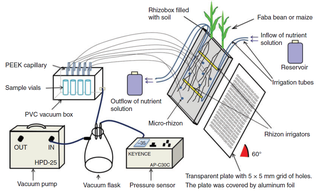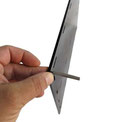RhizonBoxes for Soil Water Sampling and Manipulation
RhizonBoxes - Manipulate and Sample Soil Water ex situ

Rhizonboxes for Soil Water Sampling. In cooperation with Rhizosphere Research Products we build "RhizonBoxes" - allowing to use 1) MicroRhizons for pore water sampling (using the perforated back panel), 2) Rhizons for local soil water manipulation (e.g. salt or heavy metal infiltration) and sampling of larger water volumes (using holes in the side walls or installed from top), and 3) Rhizon Irrigators for passive irrigation.
The main difference to our classic Rhizoboxes is the 5 mm x 5 mm grid of 1.5 mm diameter holes on the rear panel, which allows the insertion of MicroRhizons (without silicone sleeves) at the desired positions (e.g. next to specific root segments (e.g. tips) or in bulk soil). Before MicroRhizons are inserted, all holes are sealed with a replaceable foil/tape (e.g. parafilm) to prevent increased gas exchange and evaporation. This foil is best installed on the inside before Rhizonbox filling; "used", open holes can be reclosed with tape from the outside.
Larger diameter Rhizons (ideally with silicone sleeves) can be inserted through 4.5-mm holes on one or two sides of the Rhizonbox to sample larger volumes of percolating soil solutions or to introduce specific solutions / water at different depths in the box. Optional silicone sleeves can securely close the 4.5 mm hole; before sampler insertion the holes can be closed with tape or similar (from the outside). Rhizonboxes are fully customizable via the configuration form (pdf); use the rhizobox configurator to approximate rooting space, weight etc. of your design.
RhizonBoxes - Features
- Ideal for root, rhizosphere and soil studies with soil water sampling or manipulation tasks
- Standard and Customised dimensions (X x Y x Z) and openings (back, side, bottom)
- Grid of holes allows for exact positioning of Microrhizon Samplers
- Extended usability with external spacers/screws, reducing the risk of wear and tear
- Small storage volume, easy to assemble/disassemble
Optional
- Fitting Microrhizon and Rhizon Soil Water Samplers, RhizonIrrigators
- Split-RhizonBoxes, with compartments
- Large range of accessories: Fitting racks, shading panels, storage boxes etc
- Replacement parts (scratched panels etc.) and same models (to increase replication etc) available for years to come
Custom Rhizonbox designs (as well as other options / accessories) can be configured using the Rhizobox Configuration Form (pdf).
Standard, inexpensive Rhizonboxes & Accessories (Racks, Light Shielding Panels) are available for trials, educational project etc. in the online store.
Rhizon-Sampler Types for RhizonBoxes

Three types of Rhizons are generally used with RhizonBoxes:
- 1) MicroRhizon (entered via the perforated rear panel; 1.5 mm holes)
- 2) Rhizon (entered from the 4.5 mm-side holes (CSS), or top (Flex)),
- 3) Rhizon Irrigator (entered from the top, or larger holes in sides).
Please note the different diameters of the MicroRhizons, Rhizon Samplers and RhizonIrrigators - and thus the different ways to insert them into the Rhizonboxes.
RhizonBox Shipping & Assembly
Rhizonboxes are shipped unassembled to reduce costs and potential damage during delivery. Read the DIY Rhizonbox assembly instructions.
Rhizonbox Example Set-up

Schematic of an example Rhizonbox experiment using MicroRhizons for soil water extraction and Rhizon Irrigators for passive irrigation from the top. For example, Liu et al. (2006) placed MicroRhizons in the soil through holes in the Rhizonbox rear panel. Each MicroRhizon was connected to a vacuum sample vial. Nutrient solutions were fed by gravity into the rhizobox soil from a raised reservoir connected to the RhizonIrrigators. See Liu et al. (2016) for details.
| References |
Rhizonboxes, Rhizons and sampling with other Microsuction Cups |
OPEN |
|
||
Microrhizons and the CSS and Flex Rhizon Samplers are particularly suitable for sampling in RhizonBoxes. RhizonIrrigators can be used for passive irrigation at different RhizonBox depths.
Consider large, mobile Rhizotrons (i.e. ultra-large rhizoboxes) and root-windows for educative displays, as mesocosms and/or for large-scale greenhouse experimentation on roots and soil.
For experiments with flooded plants, roots and soil - rice to natural wetlands - consider the standardized and leakproof hydroponic Rootboxes developed by VSI.









